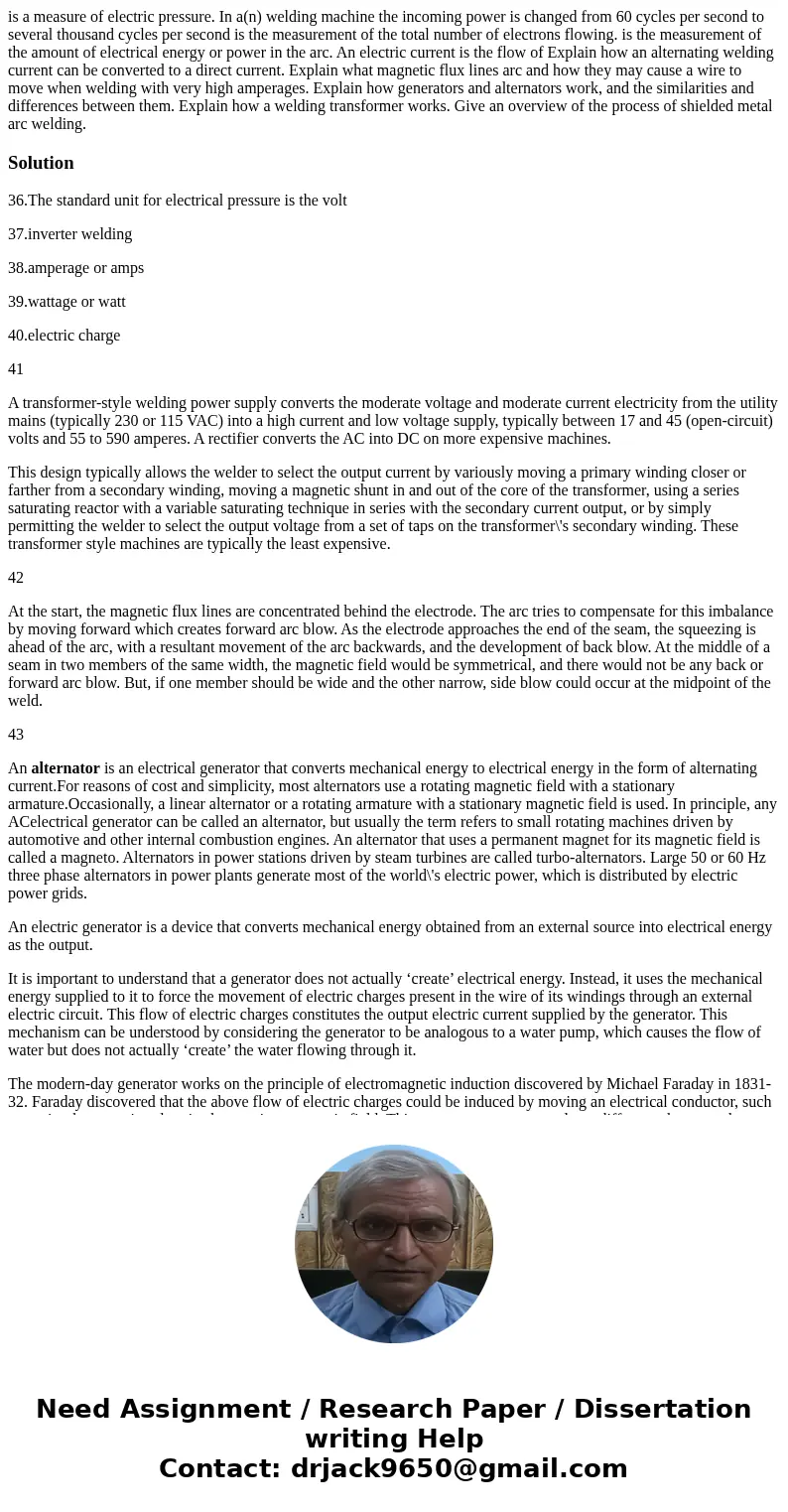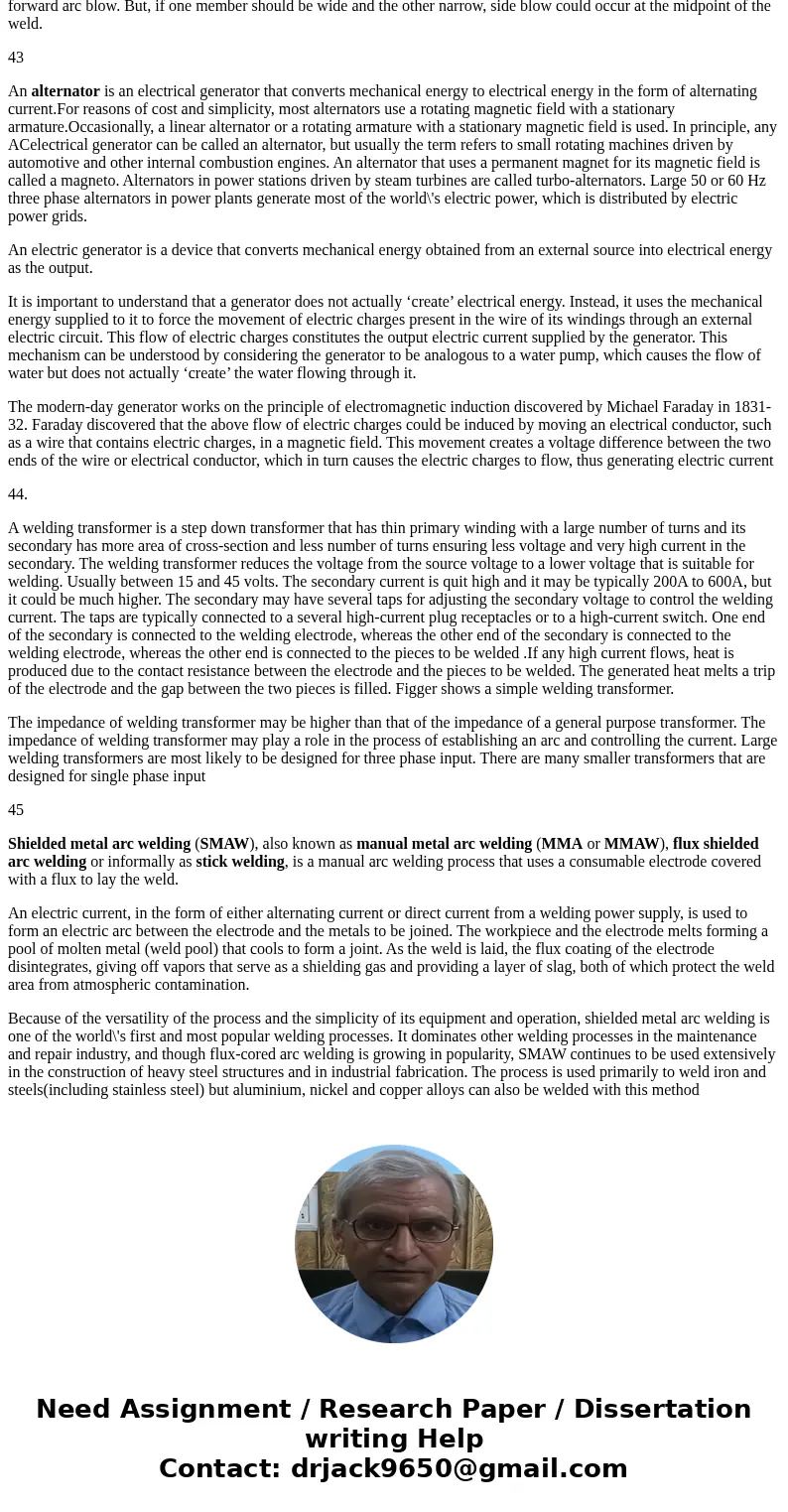is a measure of electric pressure In an welding machine the
Solution
36.The standard unit for electrical pressure is the volt
37.inverter welding
38.amperage or amps
39.wattage or watt
40.electric charge
41
A transformer-style welding power supply converts the moderate voltage and moderate current electricity from the utility mains (typically 230 or 115 VAC) into a high current and low voltage supply, typically between 17 and 45 (open-circuit) volts and 55 to 590 amperes. A rectifier converts the AC into DC on more expensive machines.
This design typically allows the welder to select the output current by variously moving a primary winding closer or farther from a secondary winding, moving a magnetic shunt in and out of the core of the transformer, using a series saturating reactor with a variable saturating technique in series with the secondary current output, or by simply permitting the welder to select the output voltage from a set of taps on the transformer\'s secondary winding. These transformer style machines are typically the least expensive.
42
At the start, the magnetic flux lines are concentrated behind the electrode. The arc tries to compensate for this imbalance by moving forward which creates forward arc blow. As the electrode approaches the end of the seam, the squeezing is ahead of the arc, with a resultant movement of the arc backwards, and the development of back blow. At the middle of a seam in two members of the same width, the magnetic field would be symmetrical, and there would not be any back or forward arc blow. But, if one member should be wide and the other narrow, side blow could occur at the midpoint of the weld.
43
An alternator is an electrical generator that converts mechanical energy to electrical energy in the form of alternating current.For reasons of cost and simplicity, most alternators use a rotating magnetic field with a stationary armature.Occasionally, a linear alternator or a rotating armature with a stationary magnetic field is used. In principle, any ACelectrical generator can be called an alternator, but usually the term refers to small rotating machines driven by automotive and other internal combustion engines. An alternator that uses a permanent magnet for its magnetic field is called a magneto. Alternators in power stations driven by steam turbines are called turbo-alternators. Large 50 or 60 Hz three phase alternators in power plants generate most of the world\'s electric power, which is distributed by electric power grids.
An electric generator is a device that converts mechanical energy obtained from an external source into electrical energy as the output.
It is important to understand that a generator does not actually ‘create’ electrical energy. Instead, it uses the mechanical energy supplied to it to force the movement of electric charges present in the wire of its windings through an external electric circuit. This flow of electric charges constitutes the output electric current supplied by the generator. This mechanism can be understood by considering the generator to be analogous to a water pump, which causes the flow of water but does not actually ‘create’ the water flowing through it.
The modern-day generator works on the principle of electromagnetic induction discovered by Michael Faraday in 1831-32. Faraday discovered that the above flow of electric charges could be induced by moving an electrical conductor, such as a wire that contains electric charges, in a magnetic field. This movement creates a voltage difference between the two ends of the wire or electrical conductor, which in turn causes the electric charges to flow, thus generating electric current
44.
A welding transformer is a step down transformer that has thin primary winding with a large number of turns and its secondary has more area of cross-section and less number of turns ensuring less voltage and very high current in the secondary. The welding transformer reduces the voltage from the source voltage to a lower voltage that is suitable for welding. Usually between 15 and 45 volts. The secondary current is quit high and it may be typically 200A to 600A, but it could be much higher. The secondary may have several taps for adjusting the secondary voltage to control the welding current. The taps are typically connected to a several high-current plug receptacles or to a high-current switch. One end of the secondary is connected to the welding electrode, whereas the other end of the secondary is connected to the welding electrode, whereas the other end is connected to the pieces to be welded .If any high current flows, heat is produced due to the contact resistance between the electrode and the pieces to be welded. The generated heat melts a trip of the electrode and the gap between the two pieces is filled. Figger shows a simple welding transformer.
The impedance of welding transformer may be higher than that of the impedance of a general purpose transformer. The impedance of welding transformer may play a role in the process of establishing an arc and controlling the current. Large welding transformers are most likely to be designed for three phase input. There are many smaller transformers that are designed for single phase input
45
Shielded metal arc welding (SMAW), also known as manual metal arc welding (MMA or MMAW), flux shielded arc welding or informally as stick welding, is a manual arc welding process that uses a consumable electrode covered with a flux to lay the weld.
An electric current, in the form of either alternating current or direct current from a welding power supply, is used to form an electric arc between the electrode and the metals to be joined. The workpiece and the electrode melts forming a pool of molten metal (weld pool) that cools to form a joint. As the weld is laid, the flux coating of the electrode disintegrates, giving off vapors that serve as a shielding gas and providing a layer of slag, both of which protect the weld area from atmospheric contamination.
Because of the versatility of the process and the simplicity of its equipment and operation, shielded metal arc welding is one of the world\'s first and most popular welding processes. It dominates other welding processes in the maintenance and repair industry, and though flux-cored arc welding is growing in popularity, SMAW continues to be used extensively in the construction of heavy steel structures and in industrial fabrication. The process is used primarily to weld iron and steels(including stainless steel) but aluminium, nickel and copper alloys can also be welded with this method


 Homework Sourse
Homework Sourse